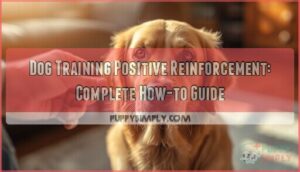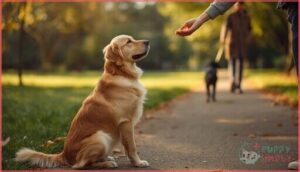This site is supported by our readers. We may earn a commission, at no cost to you, if you purchase through links.
Your dog knows exactly when you’re about to give them a treat. That laser focus, the enthusiastic sit, the intense eye contact—it all happens because their brain has learned a pattern. This isn’t luck or natural obedience. It’s operant conditioning in action, the same learning principle that shapes behavior in animals from lab rats to wild dolphins.
Dog training positive reinforcement draws on this hardwired system, teaching your dog through rewards rather than corrections. The method works because it aligns with how dogs naturally learn, creating associations between actions and pleasant outcomes.
Once you understand the mechanics behind reward-based training, you’ll see faster progress, fewer behavioral problems, and a dog who’s genuinely excited to work with you.
Table Of Contents
- Key Takeaways
- Principles of Positive Reinforcement in Dog Training
- Choosing Effective Rewards for Dogs
- Implementing Positive Reinforcement Techniques
- Training Common Dog Behaviors Positively
- Troubleshooting and Advancing Positive Reinforcement
- Frequently Asked Questions (FAQs)
- Can you train a dog with positive reinforcement only?
- What are positive reinforcement activities for dogs?
- Does positive dog training really work?
- Is positive punishment effective in dog training?
- How long does positive reinforcement training typically take?
- Can positive reinforcement work for aggressive dogs?
- Is positive reinforcement effective for older, untrained dogs?
- How do you phase out treats in positive reinforcement?
- Can positive reinforcement be combined with other training methods?
- How long does training take to show results?
- Conclusion
Key Takeaways
- Positive reinforcement training works by activating dopamine pathways in your dog’s brain, creating strong neural connections between cues, actions, and rewards—especially when you deliver treats within 1-2 seconds of the desired behavior.
- Dogs trained with reward-based methods show dramatically lower stress (8% vs 65% in aversive groups), faster compliance rates (83.5% vs 76.8%), and stronger bonds without the aggression risks that come with punishment-based approaches.
- Effective training requires strategic reward selection and delivery—start with high-value treats for new skills, then gradually shift to intermittent reinforcement schedules and mix in non-food rewards like play or environmental privileges to maintain behaviors long-term.
- Real-world reliability demands systematic progression through the Four Ds framework (duration, distance, distractions, and different contexts), building each variable slowly to keep your dog’s success rate above 80% without overwhelming them.
Principles of Positive Reinforcement in Dog Training
Positive reinforcement isn’t just about handing out treats—it’s rooted in real science that explains how dogs learn. Understanding the principles behind this method helps you train more effectively and see faster, lasting results.
Let’s break down the core concepts that make positive reinforcement work so well.
Operant Conditioning and The Four Quadrants
Operant conditioning principles form the foundation of how your dog learns from consequences. The four quadrants of operant conditioning divide training approaches into four categories:
- Positive reinforcement adds rewards to increase desired behaviors
- Negative reinforcement removes discomfort to strengthen responses
- Positive punishment adds aversive consequences to reduce unwanted actions
Modern LIMA framework guidelines prioritize reward-based methods for better welfare outcomes. This training method adjusts behavior using rewards and punishment.
How Positive Reinforcement Works
You’ve seen that operant conditioning uses consequences to shape behavior. Now let’s look at what happens in your dog’s brain when you deliver a reward. Positive reinforcement training works by activating dopamine pathways that strengthen the neural connections between the cue, your dog’s action, and the pleasant outcome—basically hardwiring the behavior you want. Understanding this neurotransmitter role(https://k9servicesunlimited.com/the-role-of-dopamine-in-dog-training/) is important to effective training.
Here’s how timing and delivery method affect your results:
| Training Element | Impact on Learning |
|---|---|
| Reward within 1–2 seconds | Strong behavior-reward association forms |
| Delay of 10+ seconds | Weak or incorrect association develops |
| Consistent marker cues | Faster acquisition, clearer communication |
| Variable reinforcement schedules | Greater behavior persistence over time |
When you reward your dog immediately after the correct response, you’re capitalizing on reward mechanisms that make repetition more likely. Marker cues like clicks bridge tiny gaps between action and treat, maintaining that significant contiguity. Early training demands a high reinforcement rate—rewarding frequently builds momentum and confidence. As behaviors become reliable, you’ll shift to variable schedules, which paradoxically make learned actions more resistant to extinction. Your dog’s willingness to keep trying, even when rewards become unpredictable, shows how positive reinforcement methods create lasting motivation and reliable performance.
Benefits Over Aversive Training Methods
When you compare positive reinforcement to punishment-based methods, the evidence is clear. Dogs trained with reward-based approaches show dramatically lower stress behaviors—studies report just 8% exhibiting stress signals versus 65% in aversive groups. You’ll see stronger bonds, better long-term efficacy, and improved welfare without the ethical concerns tied to shock collars or harsh corrections that often backfire.
Why reward-based training wins:
- Your dog learns faster without fear clouding the lesson
- Reduced stress means fewer cortisol spikes and anxious behaviors
- Aggression toward family drops when you skip punishment tactics
- Dogs stay invested and motivated rather than shutting down
- Real-world reliability holds up better than quick-fix suppression methods
Building Trust and Strengthening Bonds
Positive reinforcement training strengthens the human-dog bond by triggering oxytocin release during interactions—thereby building trusting relationships through neurochemistry. Consistent routines paired with rewards create stress modulation that fosters emotional safety, turning training sessions into relationship-building moments rather than just obedience drills.
Positive reinforcement training builds trust through oxytocin release, transforming obedience drills into relationship-building moments that create emotional safety
You’ll notice affection signals like sustained eye contact and proximity-seeking as your dog develops secure-base behavior, exploring confidently when you’re nearby.
Choosing Effective Rewards for Dogs
The secret to successful positive reinforcement training lies in finding what truly motivates your dog. Not every dog values the same rewards equally, and understanding your dog’s unique preferences will make training faster and more enjoyable for both of you.
Let’s explore the different types of rewards you can use to reinforce good behavior and keep your dog wanting to learn.
High-Value Treats and Food Rewards
Food treats pack the most punch in dog training because dogs naturally prioritize taste and smell over almost any other reward. When you’re teaching new skills, soft, bite-sized treats with strong aroma and flavor keep your dog engaged without adding too many calories to their daily intake.
- Choose highly palatable options with rich scent and texture to maintain motivation through multiple repetitions
- Break treats into pea-sized pieces so you can reward frequently without overfeeding or risking weight gain
- Account for treat calories by adjusting your dog’s main meals, keeping total treat intake under 10% of daily energy needs
- Start with top-tier food rewards for challenging behaviors, then fade to lower-value options as skills become reliable
Verbal Praise and Affirmation
Unlike treats, verbal praise alone won’t drive early positive reinforcement training—dogs generally respond much slower to “good dog” than to food during initial skill-building.
But when you pair enthusiastic, high-pitched affirmation with treats, you create a powerful secondary reinforcer that reduces stress, strengthens neural responses to your voice, and helps maintain long-term behavior once you fade primary rewards.
Physical Affection and Petting
When you scratch your dog’s back or rub their chest, you’re tapping into a reward that research shows sustains learning without the calories. Physical affection strengthens the human-dog bond through positive feedback while triggering emotional effects similar to treats—dogs choose petting over verbal praise every time.
Preference patterns vary, so watch for relaxed muscles and leaning in. Reinforcement guidelines suggest slow strokes on shoulders, back, or chest deliver the highest petting reward value for learning outcomes.
Toy Rewards and Play Sessions
You can use toy rewards and play as powerful reinforcement tools, but keep arousal levels in check. Research shows ball rewards produce 53% accuracy versus 69% with treats on precision tasks, so match the reward to the behavior.
Toy preference matters—high-arousal toys suit energy tasks, while treats excel for impulse control.
Structured play duration of 20-30 minutes after training strengthens memory consolidation and delivers welfare effects without compromising performance.
Environmental Rewards and Privileges
Your dog craves more than just treats—sometimes the environment itself is the jackpot. Environmental rewards like outdoor access, off-leash freedom, or sniffing privileges can powerfully reinforce desired behaviors while weaving positive reinforcement into everyday life. These routine privileges become life rewards that strengthen obedience naturally.
- Allow supervised yard time after your dog sits calmly at the door
- Grant sniffing rewards during walks following loose-leash segments
- Use social interaction with other dogs as motivation for reliable recall
Implementing Positive Reinforcement Techniques
Knowing your dog’s favorite rewards is just the start—the real magic happens when you deliver them at the right moment and in the right way.
The techniques you use to communicate with your dog make all the difference between confusion and clarity, between slow progress and turning points.
Timing and Consistency in Reward Delivery
Reward timing can make or break your positive reinforcement training efforts. Research shows that delivering rewards immediately—within 1 to 3 seconds of the desired behavior—dramatically improves learning success.
When reinforcement is delayed, even by just one second, dogs struggle to connect their action with the consequence. Consistent schedules and predictable handler behavior strengthen these associations, helping your dog understand exactly what earns those rewards.
Using Clickers and Markers for Clarity
Markers—whether a clicker or verbal praise like “yes”—bridge the gap between your dog’s action and the treat. Clicker precision shines during early learning; one study found dogs mastered target-touching in 36 minutes with a clicker versus 59 minutes with verbal markers.
Conditioned reinforcers like these signal exactly which behavior earned the reward, even if you’re a second late delivering the food. Handler skill matters: consistent marker timing builds clarity and confidence.
Giving Clear and Simple Command Cues
Once your marker is dialed in, cue word choice becomes your next lever. Keep commands short—over 80% of effective dog training relies on one- or two-syllable words like “sit” or “stay.”
Pair each verbal cue with a clear hand signal; dogs follow visual cues with 99% accuracy versus 82% for voice alone.
Consistency matters across every handler, and timing cuts latency. Acoustically distinct tones boost communication and keep your dog tuned in.
Shaping and Capturing Desired Behaviors
You can teach complex behaviors two ways: shaping breaks a target into smaller steps, rewarding each approximation until your dog performs the full action. Capturing waits for spontaneous actions—like a natural sit—then marks and rewards the instant they happen.
Shaping precision builds problem-solving skills and behavior chains, while capturing turns everyday moments into training wins for desired behaviors.
Gradual Progression and Managing Distractions
Once your dog reliably performs a behavior at home, it’s time to introduce real-world challenges. Gradual progression and environmental management are key—jumping straight into busy parks usually ends in frustration.
Use the Four Ds framework to proof behaviors systematically:
- Duration: Extend how long your dog holds a stay before rewarding
- Distance: Increase space between you and your dog during training sessions
- Distractions: Add environmental challenges one at a time, keeping other parameters easy
Research shows sudden high-intensity distractions—like loud noises at 85 dB—can cause dogs to refuse previously mastered tasks. That’s why distraction introduction matters. Start in quiet training environments, then slowly layer in sights, sounds, and movement. Adjust only one variable per session. If you’re working near other dogs (high distraction), keep your distance close and duration short. This progression strategy maintains your dog’s success rate above 80%, building confidence without overwhelming them.
Simple behaviors learned indoors often fall apart outdoors—not because your dog is stubborn, but because the context changed dramatically. Recognize this as a training gap, not disobedience. Dial back your expectations, rebuild the foundation in the new environment, then gradually increase difficulty again.
Welfare considerations are important here. Positive reinforcement paired with careful environmental management reduces stress and keeps training sessions productive. Dogs trained with structured distraction work show more relaxed body language and better long-term retention than those thrown into chaotic situations.
Consistency in training across different contexts—your yard, neighborhood walks, pet stores—strengthens reliability. Each successful repetition in a slightly more challenging environment builds the behavior’s durability, preparing your dog for real-life scenarios where distractions are unavoidable.
Training Common Dog Behaviors Positively
Once you’ve built a foundation in positive reinforcement techniques, it’s time to put them into practice with real behaviors. The approach stays the same whether you’re teaching a puppy to sit or helping an older dog master loose-leash walking—reward what you want to see more of.
Let’s walk through how to train the most common behaviors dog owners face, using rewards to guide your dog toward success.
Teaching Basic Obedience (Sit, Stay, Come)
You’ll build a rock-solid foundation when you master sit, stay, and recall reliability through positive reinforcement training. These dog obedience basics respond beautifully to reward-based dog training techniques—research shows dogs trained this way comply with sit commands 83.5% of the time on the first cue versus just 76.8% with aversive methods, and they respond nearly a quarter-second faster.
| Command | Success Strategy |
|---|---|
| Sit command | Reward immediately when rear touches ground; use high-value treats for speed |
| Stay duration | Build time gradually (5 seconds, then 10, then 30); return to reward often |
| Recall (Come) | Always reward arrival; positive methods achieve 82.5% first-cue compliance |
| Cue fading | Reduce hand signals slowly as verbal commands strengthen over 5+ sessions |
| Generalization training | Practice dog commands in different locations, with distractions increasing gradually |
The secret lies in timing and consistency. Mark the exact moment your dog performs correctly—that’s when the learning clicks. Studies tracking sit response times found reward-focused handlers needed fewer repeated cues (just 10.6% versus 18.9% with corrections) and maintained faster execution across training days.
Start each behavior in a quiet space, then systematically add real-world distractions. Your dog’s success rate will climb as you pair clear verbal cues with immediate, meaningful rewards—food, praise, or play sessions that your dog truly values.
Leash Training and Loose-Leash Walking
With 86% of dogs pulling on leash, you’re facing one of the most common dog training challenges—but positive reinforcement training offers the clearest path forward. Dog training techniques that reward loose-leash walking dramatically improve walking enjoyment and reduce pulling without leash corrections.
Training consistency matters: structured leash-walking programs boost owner satisfaction by 73%, and younger dogs show faster progress with age effects on behavior.
Choose proper leash-walking equipment and reward every step your dog takes by your side.
Housebreaking and Potty Training
Most puppies master housebreaking in four to six months with consistent positive reinforcement—though smaller breeds and dogs from poor prior environments may need longer. Reward timing makes all the difference: deliver treats within seconds of correct outdoor elimination to build the association clearly.
- Schedule feeding times to predict bathroom breaks and prevent housebreaking accidents
- Take puppies out after waking, playing, and eating when they naturally need to go
- Use enzymatic cleaners for accident cleanup to remove scent markers completely
- Limit unsupervised freedom with leashes or gates until desired behaviors become reliable
- Install doggy doorbells to teach your dog to signal when they need outside access
Crate Training and Creating Safe Spaces
Think of a crate as your dog’s personal sanctuary, not a cage. Positive reinforcement training makes crate introduction stress-free: toss treats inside, reward calm entries, and gradually extend duration from minutes to the recommended four-hour maximum for adults.
Design your safe space with soft bedding in a quiet corner, and watch anxiety melt away as your dog voluntarily seeks their den.
Addressing Unwanted Behaviors With Rewards
Barking and jumping don’t vanish when you punish them—they transform when you reward silence and four-on-the-floor. Reward-based DRO protocols replace behavior problems with desired behaviors: reinforce your dog during quiet intervals, and excessive vocalization drops without aversive consequences.
Owner strategies that focus on positive reinforcement training reduce stress while addressing dog behavior problems through specific interventions that strengthen alternative responses you actually want to see.
Troubleshooting and Advancing Positive Reinforcement
Even with the best approach, training doesn’t always go smoothly, and your dog’s progress may hit bumps along the way.
The good news is that most challenges have straightforward solutions, and you can keep building on what you’ve already accomplished.
Let’s look at how to work through common setbacks, improve your technique, and help your dog succeed in new situations.
Dealing With Setbacks and Regression
Even reliable behaviors can slip when life gets busy—nearly half of dog owners report that at least one cue deteriorates within a year. Regression causes often include inconsistent practice, environmental changes, or natural extinction bursts, where your dog temporarily tests boundaries harder before improving.
Addressing common training challenges means recognizing owner factors like time investment and consistency matters most:
- Maintain weekly practice sessions to prevent behavior problems from creeping back
- Expect extinction bursts when removing old rewards—don’t accidentally reinforce the spike
- Vary contexts and handlers so cues don’t become location-bound
- Use play and refreshers as recovery strategies after setbacks
Reducing dog behavior problems long-term requires patience during these normal dips.
Fading Out Treats and Varying Rewards
Once your dog consistently hits that 80–90% success mark, start moving to intermittent reinforcement by rewarding roughly every other correct response. Vary reward types—mix high-value treats with toy rewards and play, verbal praise, or environmental rewards like door access. This prevents treat dependence and builds long-term maintenance without constant food. Think of it like a slot machine: unpredictable payoffs keep motivation high while gradually fading treats entirely.
| Reward Schedule | When to Use |
|---|---|
| Continuous (every time) | Initial learning phase |
| Intermittent (50–60%) | Behavior is reliable |
| Variable (30–50%) | Long-term maintenance |
Applying Techniques in Real-Life Scenarios
Your dog’s crate behavior means nothing if he can’t settle on the vet’s exam table or ignore squirrels at the park. Implementing positive reinforcement in everyday situations moves beyond controlled home sessions and builds real reliability. Test your training where it matters most—under actual pressure:
- Public spaces: Reward calm sits around cyclists, joggers, and unfamiliar dogs; a 2019 UK survey found 74% of owners reported better recall after reward-based park practice
- Veterinary visits: Pair clinic handling with treats during exams; dogs prepared this way show 39% fewer fear behaviors
- Home routines: Reinforce calm door greetings and mealtime settling; families report 61% fewer counter-surfing incidents
- Travel training: Practice short, treat-paired car rides to reduce anxiety; structured programs cut distress signs by 64%
- Community settings: Maintain positive reinforcement techniques in stores, sidewalks, and events; service organizations report 90% task accuracy in distracting environments
Effective dog training techniques adapt to context. Start sessions short—three to five minutes in new locations—and gradually increase duration as your dog succeeds.
Advanced Training and Trick Teaching
Once your dog masters everyday environments, you can build on that foundation with complex tricks—roll over, spin on cue, or retrieve named objects. These behaviors demand shaping and precise timing, often requiring 38–45 reinforced repetitions per trick chain.
Clicker use becomes key here: 90% of trainers use markers to break down multi-step sequences, increasing dog motivation and strengthening cognitive abilities while delivering serious mental stimulation and cognitive enrichment.
Maintaining Learned Behaviors Long-Term
Teaching sophisticated tricks is just the beginning—real success depends on keeping those behaviors sharp for years. Without a maintenance plan, even the most reliable cues can weaken over time.
Lifelong practice means weaving short training sessions into daily routines—ask for a sit before meals, reinforce recall during walks, and rotate through commands during play. Context generalization matters: rehearse behaviors in different rooms, outdoors, and around distractions so your dog responds anywhere. Reward fading lets you shift from continuous treats to intermittent reinforcement and variable schedules, which build stronger habit persistence. Consistency in rewarding desired behaviors, even occasionally, prevents relapse and keeps skills fresh across your dog’s entire life.
Keep your dog’s training alive by:
- Practicing in three-minute bursts scattered throughout your week instead of marathon sessions that fade from memory
- Surprising your dog with jackpot rewards when they nail a behavior you haven’t asked for in weeks
- Asking for old tricks in brand-new places—the backyard sit should work at the vet’s office too
- Mixing life rewards like a game of fetch with food so training stays exciting year after year
- Running quick refreshers every few months to catch small errors before they become big problems
Relapse prevention isn’t complicated: stay unpredictable with your rewards, keep practice short and fun, and never assume a learned behavior will last forever without your attention.
Frequently Asked Questions (FAQs)
Can you train a dog with positive reinforcement only?
You’ll be amazed—positive reinforcement training works beautifully for nearly all behaviors, from basic obedience to complex tasks.
Research shows reward-based methods outperform aversive techniques without the stress, fear, or aggression risks punishment brings.
What are positive reinforcement activities for dogs?
Positive reinforcement activities include food-based rewards, clicker training, toy reinforcement, scent work, and social interaction. These rewarding dog behavior techniques strengthen your bond while making learning fun and engaging for your companion.
Does positive dog training really work?
Like teaching a child with encouragement rather than fear, positive reinforcement training science shows dogs trained with reward-based methods comply more reliably than those using aversive alternatives, with measurable welfare impacts and higher compliance rates.
Is positive punishment effective in dog training?
While positive punishment can suppress unwanted behaviors under strict conditions, research shows it carries significant welfare concerns, aggression risks, and practical limitations.
Scientific guidance consistently favors reward-based methods over aversive approaches for effectiveness and safety.
How long does positive reinforcement training typically take?
Most dogs master basic cues in four to eight weeks with consistent positive reinforcement training. House training generally requires four to six months.
Generalization reliability, session efficiency, and gradual progression in training demand patience and lifelong maintenance.
Can positive reinforcement work for aggressive dogs?
Yes, reward-based training works for aggressive dogs when combined with safety protocols and professional guidance. Early intervention reduces anxiety and fearful responses, while thorough plans avoid aversive risks that worsen aggression.
Is positive reinforcement effective for older, untrained dogs?
You can definitely teach an old dog new tricks. Senior dog training with positive reinforcement methods works well across all ages, maintaining lifelong learning without aversive method concerns even as cognitive decline impacts some older pets.
How do you phase out treats in positive reinforcement?
Moving to intermittent reinforcement means rewarding every second or third correct response once your dog hits 80–90% accuracy.
Gradually introduce variable schedules, mix in non-food rewards, and adjust context to prevent extinction while maintaining strong performance.
Can positive reinforcement be combined with other training methods?
Many trainers pair rewards with corrections, but research shows mixed methods increase stress indicators and aggression.
LIMA guidelines recommend exhausting positive reinforcement training methods first, as aversive techniques compromise behavioral outcomes without improving results.
How long does training take to show results?
Basic obedience responses generally emerge within 1–2 weeks of daily practice, while house training requires 4–6 months. Complex behavior modification demands 2–6 months or longer, depending on consistency, reinforcement frequency, and individual factors.
Conclusion
Think of your dog’s mind as soil that reacts to what you plant. Dog training positive reinforcement seeds growth through encouragement, not fear. You’ve learned the mechanics, chosen your rewards, and built the techniques that create lasting change.
Now it’s about consistency. Each session strengthens the bond between you, transforming obedience from a chore into a collaboration. Your dog isn’t just following commands—they’re choosing to engage with you, willingly and eagerly.
- https://pmc.ncbi.nlm.nih.gov/articles/PMC11083790/
- https://somuchpetential.com/research-why-use-positive-reinforcement-in-dog-training/
- https://malenademartini.com/wp-content/uploads/2022/01/AVSAB-Humane-Dog-Training-Position-Statement-Winter-Newsletter-February-2021-2.pdf
- https://rspcavic.org/learn/reward-based-training/
- https://www.fearfree.com/wp-content/uploads/2024/07/1-s2.0-S155878782500084X-main.pdf
















